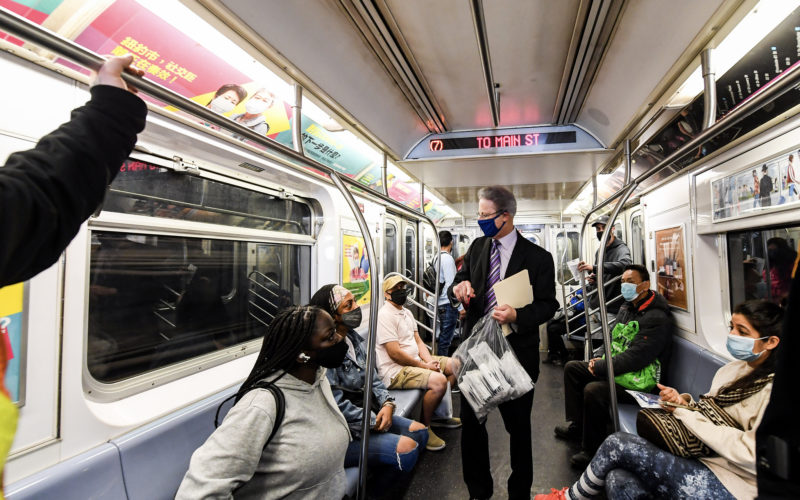

The NYC-based Riders Alliance has organized transit riders against state budget cuts. | Photo via Riders Alliance
When New York Governor Andrew Cuomo needed labor union support going into the state’s political conventions earlier this spring, he exercised his prerogative as the ultimate boss of the NYC-area Metropolitan Transportation Authority (MTA) and imposed a generous new labor agreement on the agency, winning devoted friendship from the workers. Now, a threat of a challenge from the left behind him, the Governor is adopting an attitude of detachment toward the looming possibility of a labor strike against the Long Island Rail Road (LIRR), an operating division of that very same MTA. Suddenly and uncharacteristically deferential, the Governor says Congress should deal with the LIRR matter, suggesting that federal legislators representing Texas and California (who still can’t find the wherewithal to fix the federal trust fund) are the most qualified people in the world to settle a dispute between an agency the Governor of New York controls and New York labor unions the Governor is on a first name basis with.
Just as basketball free agent Carmelo Anthony this same month theatrically makes the circuit of NBA teams in Los Angeles, Dallas and Chicago as a means of getting a better deal from the hometown Knicks, the Governor’s nod toward the U.S. Capitol dome is a well-practiced head feint. It’s a standard pattern: when the heroic workforce of the MTA labored day and night to re-open the subways after Hurricane Sandy, the Governor was right there on all channels to take credit for the miracle; when there’s bad news about on-going maintenance problems or chronic delays in major capital projects, the Governor generally has just one hard-hitting, incisive question: “The MTA? What’s that?”
A New York governor’s ambivalence toward urban transportation is no new phenomenon, and nor is it unique among the other 49 governors. The common syndrome is just more insidious in the Empire State because the high importance of public transit in this state is so diametrically opposite to the low rank the issue often occupies on a governor’s agenda. If the Governor of Wyoming doesn’t spend late nights stalking the corridors of Cheyenne urging the Wyoming legislature to improve transit, we might cut him a little slack, but lack of effort in New York has huge economic consequences for a sizable portion of U.S. transit riders.

Organizing around neighborhood transit issues has built a base with some sway in the statehouse. | Photo via Riders Alliance
New Yorkers’ awareness of the state’s responsibility for the MTA now seems to be growing, along with their willingness to hold state legislators and the governor politically accountable, in large part due to the work of a relatively new organization we admire, the Riders Alliance of New York City, which recently celebrated its second anniversary.
The Riders Alliance is a useful hybrid of consumer activism and political organizing. In its first two years of existence it has run several effective hyper-local campaigns for service improvements in particular neighborhoods and on particular transit lines. For example, they have won enhanced bus service for the Bay Ridge neighborhood of Brooklyn, and improved frequency on the G train. They accomplished that by organizing riders at the neighborhood level, and then conveying their demands to the State Senators and Assembly members from the affected districts.
Given today’s low levels of civic awareness, the average New Yorker probably thinks the subway is a responsibility of the city government, and if provoked might be inclined to send complaints to the mayor – not realizing (because it makes little sense) that the mayor of New York City may have less direct influence over the subways than a state senator from Buffalo could have. The Riders Alliance is re-directing consumer pressure where it belongs: On the statehouse in Albany. By making state legislators the recipient of their suggestions about the MTA, the Riders Alliance is gradually making the legislature’s historic ambivalence and evasiveness toward transit politically untenable, and building support for transit in both chambers. Who knows? With continued education and pressure, maybe they’ll also prevail on the Governor to recognize that transit is something that deserves support all year round, not just after extraordinary storms or before Democratic primaries.
 On the Brink: Will WMATA’s Progress Be Erased by 2024?
On the Brink: Will WMATA’s Progress Be Erased by 2024?
The experience of being a WMATA rider has substantially improved over the last 18 months, thanks to changes the agency has made like adding off-peak service and simplifying fares. Things are about to get even better with the launch of all-door boarding later this fall, overnight bus service on some lines starting in December, and an ambitious plan to redesign the Metrobus network. But all of this could go away by July 1, 2024.
Read More What’s Going on With Transit Service at the Seven Highest Ridership U.S. Cities? NYC Edition
What’s Going on With Transit Service at the Seven Highest Ridership U.S. Cities? NYC Edition
New York City Transit’s service levels have remained remarkably strong throughout the pandemic. Crew operator availability remains the agency’s biggest challenge, as well as adjusting weekend maintenance schedules in order to run service that matches strong weekend demand.
Read More